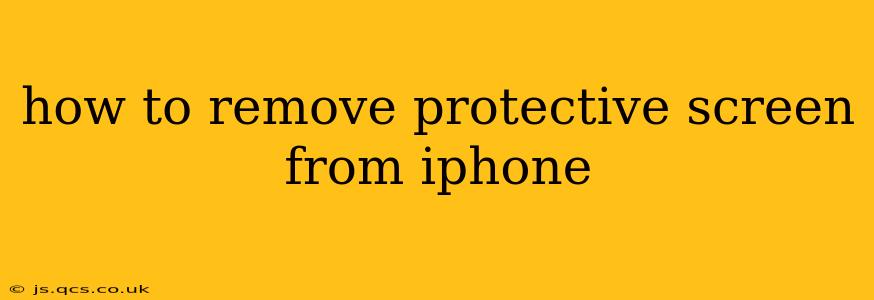Removing a screen protector from your iPhone can seem daunting, but with the right technique, you can do it without damaging your phone's screen. This guide provides a comprehensive, step-by-step process, addressing common concerns and offering tips for a smooth removal.
What You'll Need:
Before you begin, gather these materials:
- A clean, lint-free cloth: Microfiber cloths are ideal.
- Isopropyl alcohol (optional): A low concentration (70%) is sufficient. This helps loosen adhesive.
- A plastic card or guitar pick (optional): These tools help lift edges without scratching the screen.
- Patience: Rushing the process can lead to damage.
Step-by-Step Removal Process:
-
Preparation: Turn off your iPhone. This prevents accidental activation during the removal process. Clean your hands thoroughly to avoid transferring oils or dirt.
-
Locate a starting point: Find a corner of the screen protector that is slightly lifted or has a visible edge. This makes initiating the removal easier.
-
Gentle Lifting: Use your fingernail or the edge of a plastic card to gently lift a small section of the screen protector from the corner you’ve chosen. Avoid using sharp objects that could scratch your iPhone's display.
-
Slow and Steady Peel: Once you have a small section lifted, slowly peel the screen protector away from the screen. Maintain a consistent, even pressure to avoid tearing the protector or creating bubbles.
-
Address Adhesive Residue: If any adhesive residue remains on the screen, gently wipe it away with the lint-free cloth. If necessary, apply a small amount of isopropyl alcohol to the cloth (not directly onto the screen) to help dissolve the residue. Be cautious when using alcohol; use sparingly and never spray directly onto the screen.
-
Final Cleaning: Once all the screen protector and adhesive is removed, use the lint-free cloth to thoroughly clean your iPhone's screen.
Troubleshooting Common Problems:
The screen protector is stuck and won't lift:
Try applying gentle heat using a hairdryer on a low setting to soften the adhesive. Hold the hairdryer a few inches away from the screen to avoid overheating. Work slowly and carefully, as overheating can damage the screen.
The screen protector is tearing:
If the screen protector is tearing, try using the plastic card to gently lift and separate the remaining sections.
There's adhesive residue left on the screen:
Use a lint-free cloth with a small amount of isopropyl alcohol to remove the residue. For stubborn residue, try a screen cleaning solution specifically designed for removing adhesive.
Why is my screen protector so hard to remove?
The difficulty in removing a screen protector often depends on the type of adhesive used. Some adhesives are stronger than others and can bond more tightly to the screen. Also, the length of time the screen protector has been on the device can affect its adherence. Older screen protectors tend to be more difficult to remove.
Can I use a razor blade to remove the screen protector?
No, absolutely not. A razor blade is far too sharp and risks severely damaging your iPhone's screen. Use only soft tools like fingernails or plastic cards.
Should I use soap and water?
While some methods suggest using soap and water, it’s generally best to avoid this as it can leave residue on your iPhone's screen. Isopropyl alcohol is a safer option for cleaning adhesive residue.
By following these steps carefully, you can successfully remove your iPhone's screen protector and maintain your phone's pristine condition. Remember, patience and gentle pressure are key.
